Table of Contents
In this blog post, I demonstrate four different abdominal exercises for osteoporosis. The four exercises presented in this post progress from beginner level to advanced abdominal exercises (for athletic and elite level individuals). All of the abdominal exercises strengthen the muscles in the core and bones in the spine, and are ideal for people with osteoporosis, osteopenia and low bone density.
At the end of the post, I recommend a different set of core strengthening exercises that not only strengthen the abdominal area but also build bone and muscle strength in the arms, forearms and hands. You can graduate to these exercises once you get a command of the ones presented in this blog post.
Abdominal Exercise Benefits
The right abdominal exercises done with good form increases abdominal strength. Abdominal strength is important for all individuals — this is true for people of all ages. Most studies have been done with individuals who are young and athletic. Few have been done on older, non-athletic individuals with co-morbidities such as arthritis and osteoporosis.
The benefits from the abdominal exercises in this post are:
- Reduce the incidence of lower back pain.
- Improved balance with a resulting reduction in the risk of a fall and fracture.
- Better use of the pelvic floor during exercise, movement and activity.
- A more stable spine.
Abdominal Exercise Reduces Back Pain
In a recent study, Japanese researchers showed that elderly women with a history of back pain and of falling had significantly lower abdominal strength when compared to elderly women without back pain and without a history of falls.
Their paper stated that “previous studies have indicated that trunk muscle strength decreases with chronic low back pain, and is associated with poor balance, poor functional performance, and falls in older adults. Strengthening exercises for chronic low back pain are considered the most effective intervention to improve functional outcomes.” (1)
The “functional outcomes” and “functional performance” that the authors mention refers to your ability to perform day-to-day activities and exercise. In other words, day to day movements become easier and can be carried out with less effort.
The research showed that just as with younger adults, strong core and strong abdominal muscles reduce the incidence of two things in older adults:
- Lower back pain.
- Falls from loss of balance and functional performance.
Stronger Abdominals Lead to Improved Balance and Reduced Fall Risk
There are many factors that can increase a person’s risk for falling. A few include the pharmaceuticals they take, poor vision, neuropathy, and poor foot wear.
Weak abdominals make it harder for an individual to maintain a stable centre of gravity. With a weak inner core, an individuals’s sway increases as they attempt to regain balance. Increased strength in the transverse abdominis, internal and external oblique muscles provides the stability you need to maintain your balance during movement. Better balance leads to a reduced risk of a fall.
Read my post on 25 ways to reduce your risk of a fall.
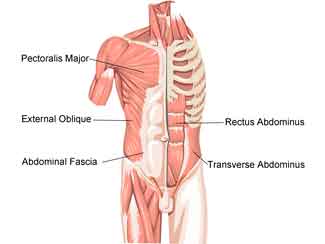
Transverse Abdominis Exercise and Lumbar Spine Support
A number of people come to see me for Physical Therapy because they experience low back pain when getting out of bed, doing yard work or during exercise. The four abdominal exercises can address this problem.
Strong transverse abdominis, internal and external oblique muscles provides stability to the lumbar and lower thoracic spine. The support reduces pain and shearing of the spine. This increased stability on the spine, in turn, in turn, may reduce lower back pain and the likelihood of developing back pain.
Increased strength in the transverse abdominis, internal and external oblique muscles also provides the stability you need to maintain your balance during movement. Better balance leads to a reduced risk of a fall.
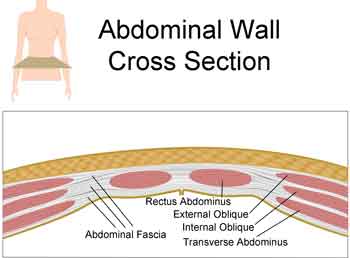
Abdominal Exercises and Pelvic Health
I would add another benefit that the research team did not point out: abdominal strength contributes to better pelvic health. This is why in each of the exercises in this blog post, I encourage you to activate your pelvic floor muscles.
For each exercise I ask you to activate of your pelvic floor muscles before you activate your deep transverse abdominal and oblique muscles. This is critical for keeping your pelvic floor safe from the strong intra-abdominal pressure that is generated during abdominal exercises. This is especially critical if you currently leak urine when you cough, sneeze, laugh or exercise.
Improved Bone Heath
Each of the abdominal exercises in this post is meant to improve muscular strength of the transverse abdominis, internal and external oblique muscles. Stability of the deep core is critical when lifting weight. Without stability around the spine the more superficial muscles of the trunk and pelvis create shearing forces to the spine. This increased load, over time, improves bone density and health.
Later in the post, I will introduce exercises that build on the four presented here that increase strength not only in transverse abdominis, internal and external oblique muscles but also build strength in the next two layers of abdominals:
- External oblique muscles.
- Internal oblique muscles.
Why I Recommend These Over Traditional Abdominal Exercises
Community exercise classes keep you motivated to move, stay active and meet friends. However, some of the movements and exercises in these group exercise classes are not recommended if you have osteoporosis, osteopenia or low bone density. This is particularly true for the abdominal exercises frequently found in exercise classes.
Personal trainers and fitness instructors, while well-meaning, are often not informed on issues related to bone health and exercise. Many a client has shared with me that their fitness instructor still includes sit ups and double leg drops as part of their exercise class. These exercises need to be removed from your routine and replaced with exercises that are safer and more effective, The four exercises I present in this blog post fit the bill on all fronts.
Traditional ab activation exercises, such as sit ups and crunches, not only reinforce poor posture, they also do not teach us to maintain the alignment of our head, torso, spine, and pelvis. Maintaining a neutral body position requires the activation of deep core muscles that are attached to our spine. The “carry over” of this perfect posture is critical for all kinds of day-to-day tasks.
You can learn more about this topic by reading my post on exercises you should avoid if you have osteoporosis.
Abdominal Exercises for Osteoporosis
The four abdominal exercises for osteoporosis are:
- Beginner Level Abdominal Exercise
- Active Level Abdominal Exercise with Leg Drop
- Athletic Level Abdominal Exercise with 90/90 Leg Drop
- Elite Level Advanced Abdominal Exercise with Leg Drop
Let’s start with the Beginner Level Abdominal Exercise for Osteoporosis.
Beginner Level Abdominal Exercise
The Beginner Level Abdominal Exercise targets the transverse abdominal muscles and the spine. It is the first of four abdominal exercises for osteoporosis from the Exercise for Better Bones program.
Directions for Transverse Abdominis Exercise for Beginners
Follow these step-by-step directions to do the first of these transverse abdominis, internal and external oblique muscles exercises.
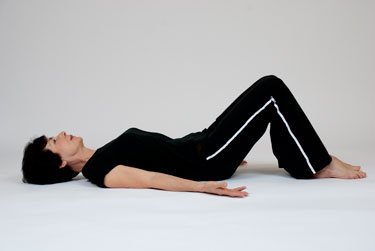
Setup
- Have a small towel handy for the small of your back. Alternatively, you can place your hand in the small of your back.
- Come down safely onto your side and then roll onto your back.
- Place either the towel or your hand in the small of the back. I prefer a towel because it gets you out of this forward roundedness position and then you can just focus in on your deep abdominals.
- Use the heel of your hand at the base where your thumb is and place that across your two hip bones. One on either side.
- Allow your thumbs to point down towards your groin.
- Have your knees and feet hip-width apart.
Tighten the Pelvic Floor
- Take a nice breath in and then slowly, gently exhaling, start tightening your pelvic floor ever so gently.
Engaging Your Deep Abdominals
- Then, you want to then move up and feel as though you’re pulling your two hip bones together.
- You should feel the muscles underneath your thumbs start to tighten up.
- This is what we refer to as recruiting your deep abdominals, or engaging your deep abdominals.
- That’s something that you should have taken with you with all the exercises.
- Start building the endurance of those muscles. Target holding them for 5, 10, 15 seconds.

Repeat
- Let’s do that again and this time we’re going to hold it through several breaths.
- Start by tightening your pelvic floor through exhalation, and then tighten your deep abdominals by pulling your hip bones together.
- For some people, pulling them apart is another cue that seems to work. You’re drawing your belly button towards your spine. You want to keep that firm, even as you’re breathing, even as you’re talking.
- You want to hold that firm throughout so that you’re building the endurance of those muscles.
- Good, and then relax.
Doing that on your back is a nice way to start. Ultimately, you want to be able to do that whether you’re standing or sitting, or in any position. As we progress through the exercises, you’re able to use your deep abdominals through all the exercises for stability.
Exercise Recommendations for Osteoporosis
Exercise is an essential ingredient to bone health. If you have osteoporosis, therapeutic exercise needs to be part of your osteoporosis treatment program.
But what exercises should you do and which ones should you avoid? What exercises build bone and which ones reduce your chance of a fracture? Is Yoga good for your bones? Who should you trust when it comes to exercises for osteoporosis?
A great resource on exercise and osteoporosis is my free, seven day email course called Exercise Recommendations for Osteoporosis. After you provide your email address, you will receive seven consecutive online educational videos on bone health — one lesson each day. You can look at the videos at anytime and as often as you like.

I cover important topics related to osteoporosis exercise including:
- Can exercise reverse osteoporosis?
- Stop the stoop — how to avoid kyphosis and rounded shoulders.
- Key components of an osteoporosis exercise program.
- Key principles of bone building.
- Exercises you should avoid if you have osteoporosis.
- Yoga and osteoporosis — should you practice yoga if you have osteoporosis?
- Core strength and osteoporosis — why is core strength important if you have osteoporosis?
Enter your email address and I will start you on this free course. I do not SPAM or share your email address (or any information) with third parties. You can unsubscribe from my mail list at any time.
Active Level Abdominal Exercise with Leg Drop
The Active Level Abdominal Exercise with Leg Drop for Active level targets the transverse abdominal muscles and the spine. It is the second of four abdominal exercises for osteoporosis from the Exercise for Better Bones program.
Directions
Follow these step-by-step directions to do the second of these exercises.
Setup
- Have a small rolled towel about the size of your hand.
- Place in the small of your back.
- Go down to the side.
- Get on your back.
- Ensure that the towel support is right in the hollow of your back.
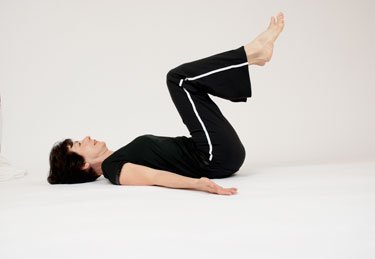
Activate Pelvic Floor and Tighten Deep Abdominals
- Either use your hands to feel your deep abdominal muscles just inside your pelvis or allow your arms to rest down by your side.
- Bring one knee up towards your chest, a little bit past 90 degrees.
- Join it with the other knee up towards your chest.
- Now, in this position, your pelvis will be tilted slightly. This will help your abdominals initially.
- Take a nice big breath.
- Slowly, gently, tighten your deep abdominals.
- Start by tightening your pelvic floor and you feel as though you’re pulling your hip bones together.
Lower Your Leg
- The objective is to lower one leg towards the floor, but do not let the small of your back lift off of the towel.
- Keep that same amount of pressure on the towel the entire time.
- Breathe in.
- Gently tighten your pelvic floor and your deep abdominals as you come down, and back up.
- Think about your lower tummy.
- Breathe in, engage or tighten your pelvic floor and your lower tummy.
- Drop one leg towards the floor, and then back up again.
- Repeat.
If you find alternative movements challenging, start by doing the right side only for five repetitions and then the left side only for five repetitions.
At any point if you feel that you can’t hold that position anymore, take a break and then start over again.
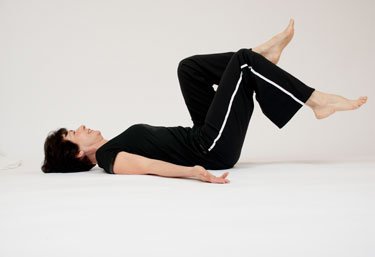
Athletic Level Abdominal Exercise with 90/90 Leg Drop
The Athletic Level Abdominal Exercise with 90/90 Leg Drop targets the transverse abdominal muscles and the spine. It is the third of four abdominal exercises for osteoporosis from the Exercise for Better Bones program.
Directions for Athletic Level Advanced Abdominal Exercise
Follow these step-by-step directions to do the third of these exercises.
Setup
- If you don’t want to use your hand, use a small towel.
- The size of that towel should be pretty well the size of your hand, both in with and depth.
- Down your side on to your back.
- The towel should be adjusted to the small of your back.
Engage Pelvic Floor. Keep Abdominals Tight. Raise Leg.
- Raise one leg to 90 degrees, the other leg to 90 degrees.
- Shoulders down the back.
- Keep your abdominals nice and tight, don’t let your low back drop.
- Keep your tummy firm the whole time and engage your pelvic floor as well.
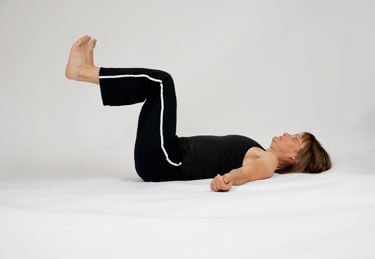
How to Increase the Intensity of Athletic Advanced Ab Exercise
The angle of your thigh is going to change the intensity of this exercise. If you do the exercise and you find that you’re not quite able to maintain that neutral position, you can make things easier by altering the angle of your legs.
- The closer your knees are to your chest, the lesser the load.
- The farther your knees are from your chest, the greater the load.
You can also increase intensity by adding arm movement. Keep your legs still (as illustrated in the photo above) and alternate arm reaches.
A further progression would be to alternate arm and leg movement concurrently. (2)
That’s a nice way to be able to adjust the intensity of this exercise to fit you.
Elite Level Advanced Abdominal Exercise with Leg Drop
The Elite Level Advanced Abdominal Exercise Leg Drops targets the transverse abdominal muscles and the spine. It is the last of four abdominal exercises for osteoporosis from the Exercise for Better Bones program.
Directions for Elite Level Advanced Abdominal Exercise
Follow these step-by-step directions to do the third of these exercises:
- Place either your hand or a towel (that’s the size of your hand) in the small of your back for this exercise.
- Start by raising one leg then the other leg.
- As in the athletic level (above), you can fine-tune this exercise by how much hip flexion you allow yourself in the resting leg.
- Increase the intensity by increasing the load of the weight. You do this by straightening the leg like this during the motion.
- We either repeat on the same side … or we can alternate side to side.
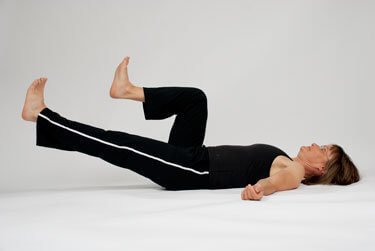
How to Adjust the Elite Advanced Ab Exercise
Another way of adjusting this exercise is how low you allow this leg to come. If you’re finding you’re just straightening your leg and your low back is starting to pull up, that’s the level that you have to start pulling back at.
Work within your limit. When you feel your back being lifted off from your lumbar support pad, it is a signal that your deep hip muscles are overpowering your abdominal muscles. This can lead to back pain or strain.
As you get stronger, you will be able to hold lower and lower until you’re able to hover just above the ground and back up. But if you allow yourself to cheat, you’re never going to allow your muscles to get stronger.
Exercise Recommendations for Osteoporosis
Exercise is an essential ingredient to bone health. If you have osteoporosis, therapeutic exercise needs to be part of your osteoporosis treatment program.
But what exercises should you do and which ones should you avoid? What exercises build bone and which ones reduce your chance of a fracture? Is Yoga good for your bones? Who should you trust when it comes to exercises for osteoporosis?
A great resource on exercise and osteoporosis is my free, seven day email course called Exercise Recommendations for Osteoporosis. After you provide your email address, you will receive seven consecutive online educational videos on bone health — one lesson each day. You can look at the videos at anytime and as often as you like.

I cover important topics related to osteoporosis exercise including:
- Can exercise reverse osteoporosis?
- Stop the stoop — how to avoid kyphosis and rounded shoulders.
- Key components of an osteoporosis exercise program.
- Key principles of bone building.
- Exercises you should avoid if you have osteoporosis.
- Yoga and osteoporosis — should you practice yoga if you have osteoporosis?
- Core strength and osteoporosis — why is core strength important if you have osteoporosis?
Enter your email address and I will start you on this free course. I do not SPAM or share your email address (or any information) with third parties. You can unsubscribe from my mail list at any time.
Core Exercises for Osteoporosis
Many abdominal exercises, including the ones listed above, involve movements that are only done while lying on your back. The transverse abdominis, internal and external oblique muscles exercises listed above are a great place to start. You can lie on the floor and practice and learn the proper movements associated with the abdominal muscles and the pelvic floor. Eventually, you can take this learned ability to activate the core and introduce instability into your exercises.
Why introduce instability with another set of exercises?
While these ab activation exercises are important foundational movements, they lack component that is important for keeping our the bones in our arms strong. Namely, they do not include loading or weight bearing.
I encourage my clients to build bone strength in the upper body while strengthening their abdominals. Planks and side-planks are ideal exercises to achieve that goal.
Bones respond well to gradual, progressive loading. You can start with plank and side plank exercises that load through your forearms. This allows you to strengthen your core without causing undue stress on your shoulder. The benefit of strong arms? Strong arms allow you to catch yourself in case of a fall.
You can progress to weight bearing through your hands. Strong hand muscles and bones are essential for any one wanting to reduce their risk of a wrist fracture.
If you want to continue on your journey and want more abdominal exercises for osteoporosis, check my page dedicated to core exercises.
Conclusion
We covered a lot of ground in this blog post on abdominal exercises for osteoporosis. Before describing the four exercises in detail, we covered the key benefits of these exercises, we discussed why you should do these exercises instead of the traditional sit ups and crunches seen in many exercise classes, and finally, we saw how you can graduate from these exercises to planks and side planks. The benefits of the planks and side planks as core exercises for osteoporosis is that they introduce instability and weight bearing into your exercise program.
References
- Kato S, et al. Abdominal trunk muscle weakness and its association with chronic low back pain and risk of falling in older women. BMC Musculoskeletal Disorders 2019 20:273. Published: 3 June 2019.
- Selkow NM, et al. Transversus Abdominis Activation and Timing Improves Following Core Stability Training: A Randomized Trial. International Journal of Sports Physical Therapy. 2017 Dec; 12(7): 1048–1056.
Osteoporosis Exercise Plan
Visit my Osteoporosis Exercise Plan page for more information on this topic.

Comments
September 5, 2016 at 9:43pm
Mary Barrett
What are the titles of the three books Margaret Martin has written. I've been informed I have 4 compression fractures : T9,T12, L1, L3,
September 6, 2016 at 7:19am
Richard Martin replies
Hi Mary - Margaret's books are:
http://melioguide.com/products/exercise-for-better-bones-program/
http://melioguide.com/products/yoga-for-better-bones/
http://melioguide.com/products/strengthen-your-core/
September 5, 2016 at 9:44pm
Mary Barrett
excellent videos
September 5, 2020 at 10:34pm
Nancy Newman
Thanks for the detailed demonstration of the abdominal activation with drop 90/90. It is a helpful supplement to the description in the book.
In the 3 day a week schedule for the athletic (and elite) level you recommend doing the abdominal activation exercise "1 Set/ 20 Sec. hold". What does 20 second hold mean? And how many reps do you recommend for the the first and second sets?
Thanks again.
September 13, 2020 at 3:13pm
Margaret Martin replies
Hi Nancy, You are very welcome. I am glad it was helpful. In the athletic and elite level, you want to do your leg drops at an intensity that allows you to feel challenged within 20 seconds or so. By adjusting the position of the stationary leg, the speed and depth at which you move the opposite leg you will get to know what your best load level is.
If you are looking to further Improve core strength, I recommend my book Strengthen Your Core. If you are new to Planks and Side Planks you might want to start at the Beginner or Active Level to ensure you have the posture and form to stay safe and strong into the Athletic and Elite Level Planks and Side Planks. It will keep you progressing for some time.
Thank you for supporting my work.
Stay safe and keep strong.
Margaret
February 27, 2021 at 4:46pm
Deborah Marko
I am osteoporotic and have been performing modified crunches for about 28 years.
Feet flat on the floor, or not. Back is stiff, and the crunch is simply moving toward the ceiling. Moving off the floor while shoulder blades remain on the floor. The hands are placed behind the neck. This is a very affective. I perform them in sets of 50, resting and deep breathing in between. I generally perform between 500 and 750 modified crunches.
I just reviewed your exercises for deep abdominal muscles and will add those to my regimen. How many do you recommend.
Thank you,
Deborah
February 27, 2021 at 5:24pm
Richard Martin replies
Hi Deborah. These exercises and recommended sets are in Margaret's book, Exercise for Better Bones. http://melioguide.com/products/exercise-for-better-bones-program/